See also
- Taliesin West, Frank Lloyd Wright's studio in Scottsdale, Arizona, USA
- Tre-Taliesin, a village in Ceredigion, Wales, UK
- All pages with titles beginning with Taliesin
- All pages with titles containing Taliesin
Taliesin was a 6th-century Welsh poet and bard.
Taliesin may also refer to:

Frank Lloyd Wright Sr. was an American architect, designer, writer, and educator. He designed more than 1,000 structures over a creative period of 70 years. Wright played a key role in the architectural movements of the twentieth century, influencing architects worldwide through his works and mentoring hundreds of apprentices in his Taliesin Fellowship. Wright believed in designing in harmony with humanity and the environment, a philosophy he called organic architecture. This philosophy was exemplified in Fallingwater (1935), which has been called "the best all-time work of American architecture".

In Celtic cultures, a bard is a professional story teller, verse-maker, music composer, oral historian and genealogist, employed by a patron to commemorate one or more of the patron's ancestors and to praise the patron's own activities.

Taliesin was an early Brittonic poet of Sub-Roman Britain whose work has possibly survived in a Middle Welsh manuscript, the Book of Taliesin. Taliesin was a renowned bard who is believed to have sung at the courts of at least three kings.

The Mabinogion are the earliest Welsh prose stories, and belong to the Matter of Britain. The stories were compiled in Middle Welsh in the 12th–13th centuries from earlier oral traditions. There are two main source manuscripts, created c. 1350–1410, as well as a few earlier fragments. The title covers a collection of eleven prose stories of widely different types, offering drama, philosophy, romance, tragedy, fantasy and humour, and created by various narrators over time. There is a classic hero quest, "Culhwch and Olwen"; a historic legend in "Lludd and Llefelys", complete with glimpses of a far off age; and other tales portray a very different King Arthur from the later popular versions. The highly sophisticated complexity of the Four Branches of the Mabinogi defies categorisation. The stories are so diverse that it has been argued that they are not even a true collection.
Cad Goddeu is a medieval Welsh poem preserved in the 14th-century manuscript known as the Book of Taliesin. The poem refers to a traditional story in which the legendary enchanter Gwydion animates the trees of the forest to fight as his army. The poem is especially notable for its striking and enigmatic symbolism and the wide variety of interpretations this has occasioned.

Edward Williams, better known by his bardic name Iolo Morganwg, was a Welsh antiquarian, poet and collector. He was seen as an expert collector of Medieval Welsh literature, but it emerged after his death that he had forged several manuscripts, notably some of the Third Series of Welsh Triads. Even so, he had a lasting impact on Welsh culture, notably in founding the secret society known as the Gorsedd, through which Iolo Morganwg successfully co-opted the 18th-century Eisteddfod revival. The philosophy he spread in his forgeries has had an enormous impact upon neo-Druidism. His bardic name is Welsh for "Iolo of Glamorgan".
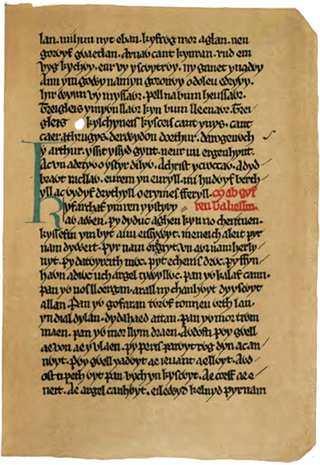
The Book of Taliesin is one of the most famous of Middle Welsh manuscripts, dating from the first half of the 14th century though many of the fifty-six poems it preserves are taken to originate in the 10th century or before.

Taliesin, sometimes known as Taliesin East, Taliesin Spring Green, or Taliesin North after 1937, is a historic property located 2.5 miles (4.0 km) south of the village of Spring Green, Wisconsin, United States. It was the estate of American architect Frank Lloyd Wright and an extended exemplar of the Prairie School of architecture. The expansive house-studio set on the brow of a ridge was begun in 1911; the 600-acre (240 ha) property was developed on land that previously belonged to Wright's maternal family.
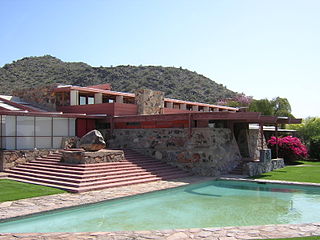
Taliesin West was architect Frank Lloyd Wright's winter home and studio in the desert from 1937 until his death in 1959 at the age of 91. It is the headquarters of the Frank Lloyd Wright Foundation.
Awen is a Welsh, Cornish and Breton word for "inspiration".

Martha Bouton "Mamah" Borthwick was an American translator who had a romantic relationship with architect Frank Lloyd Wright, which ended when she was murdered. She and Wright were instrumental in bringing the ideas and writings of Swedish feminist Ellen Key to American audiences. Wright built his famous settlement called Taliesin in Wisconsin for her, in part, to shield her from aggressive reporters and the negative public sentiment surrounding their non-married status. Both had left their spouses and children in 1909 in order to live together and were the subject of relentless public censure. In 1914, a disturbed member of the staff at Taliesin suddenly went on a murder-suicide spree at the estate killing Borthwick, two of her children and others. Wright was away at the time.

Shining Brow is an English language opera by the American composer Daron Hagen, first performed by the Madison Opera in Madison, Wisconsin, April 21, 1993. The libretto is by Paul Muldoon, and is based on a treatment co-written with the composer. The story concerns events in the life of architect Frank Lloyd Wright. Hagen invited Muldoon to write the libretto while the two were both in residency at the MacDowell Colony, in Peterborough, New Hampshire during the summer of 1989.
Loving Frank is a 2007 American novel by Nancy Horan. It tells the story of Mamah Borthwick's illicit love affair with Frank Lloyd Wright and the public shame they experienced in early twentieth century America. It is a fictionalised account told from Borthwick's perspective, based on research conducted by Horan, and it is her debut novel. It depicts Borthwick’s life as it became intertwined with Wright's between the years of 1907 through 1914. By following the artistic aspirations and travels of the two main protagonists, the novel portrays the social mores of the times in the United States and Europe.

Tan-y-Deri, is also known as the Andrew T. Porter Home and the Jane and Andrew Porter Home. Jane Porter (1869–1953) was the sister of architect Frank Lloyd Wright. The home was commissioned from Wright in 1907, with Jane and Andrew Porter (1858–1948) moving in with their children James (1901–1912) and Anna (1905–1934) by late January 1908. The home stands in a valley in the town of Wyoming, Wisconsin. This valley was originally settled by the Lloyd Joneses, who were the family of Wright and his sister's mother. The Lloyd Joneses were originally from Wales and, as a result of this heritage, Wright chose a Welsh name for the Porter home: “Tan-y-deri” is Welsh for “Under the oaks”.
Taliesin Williams was a Welsh poet and author, and son of the notable Iolo Morganwg.

Elizabeth (Bauer) Mock was director of the Department of Architecture and Design at the Museum of Modern Art (MoMA) and a university professor. She was a charter apprentice at Frank Lloyd Wright's Taliesin, and the first former Taliesin fellow to join the MoMA staff. She was an influential advocate for modern architecture in the United States.
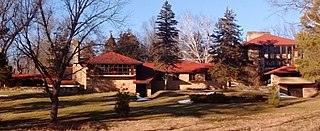
The Hillside Home School II was originally designed by architect Frank Lloyd Wright in 1901 for his aunts Jane and Ellen C. Lloyd Jones in the town of Wyoming, Wisconsin. The Lloyd Jones sisters commissioned the building to provide classrooms for their school, also known as the Hillside Home School. The Hillside Home School structure is on the Taliesin estate, which was declared a National Historic Landmark in 1976. There are four other Wright-designed buildings on the estate : the Romeo and Juliet Windmill tower, Tan-y-Deri, Midway Barn, and Wright's home, Taliesin.
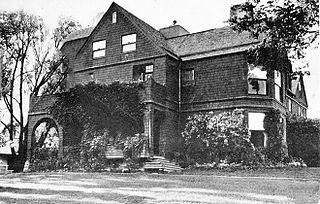
Hillside Home School I, also known as the Hillside Home Building, was a Shingle Style building that architect Frank Lloyd Wright designed in 1887 for his aunts, Ellen and Jane Lloyd Jones for their Hillside Home School in the town of Wyoming, Wisconsin. The building functioned as a dormitory and library. Wright had the building demolished in 1950.
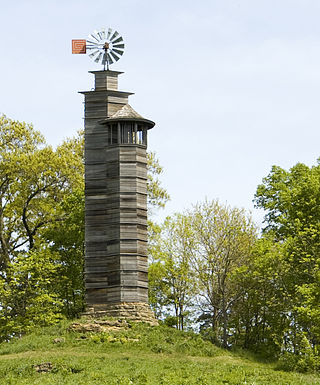
The Romeo and Juliet Windmill is a wooden structure designed by architect Frank Lloyd Wright in the town of Wyoming, Wisconsin. The building is on the Taliesin estate and was declared a National Historic Landmark in 1976.

The School of Architecture is a private architecture school in Paradise Valley, Arizona. It was founded in 1986 as an accredited school by surviving members of the Taliesin Fellowship. The school offers a Master of Architecture program focusing on the organic architecture design philosophy of Frank Lloyd Wright. The school is the smallest accredited graduate architecture program in the United States and emphasizes hands-on learning, architectural immersion, experimentation, and a design-build program that grew out of the Taliesin Fellowships’ tradition of building shelters in the Arizona desert. The school is not ranked by any ranking publications.